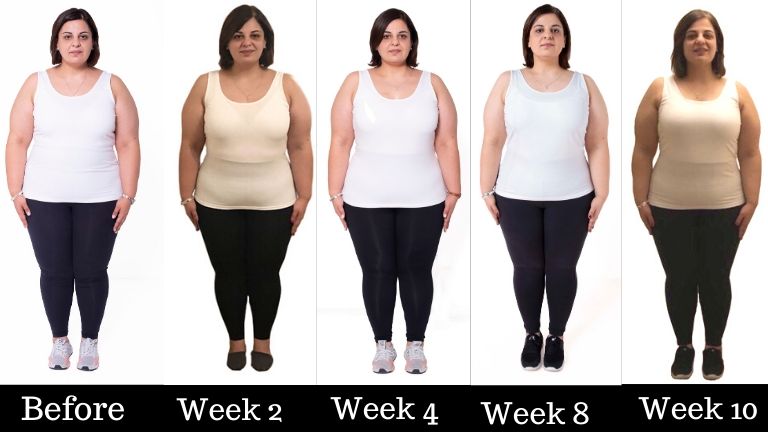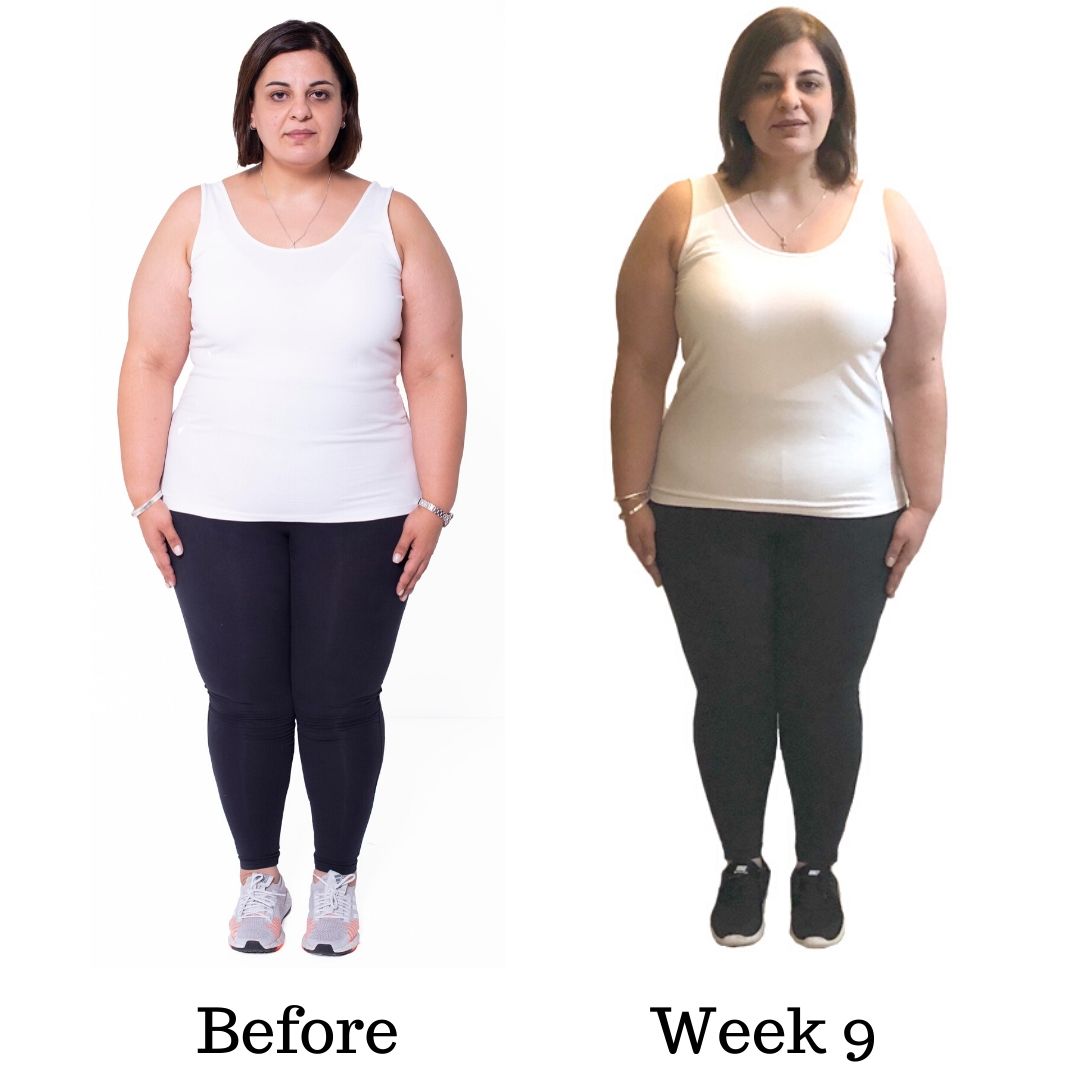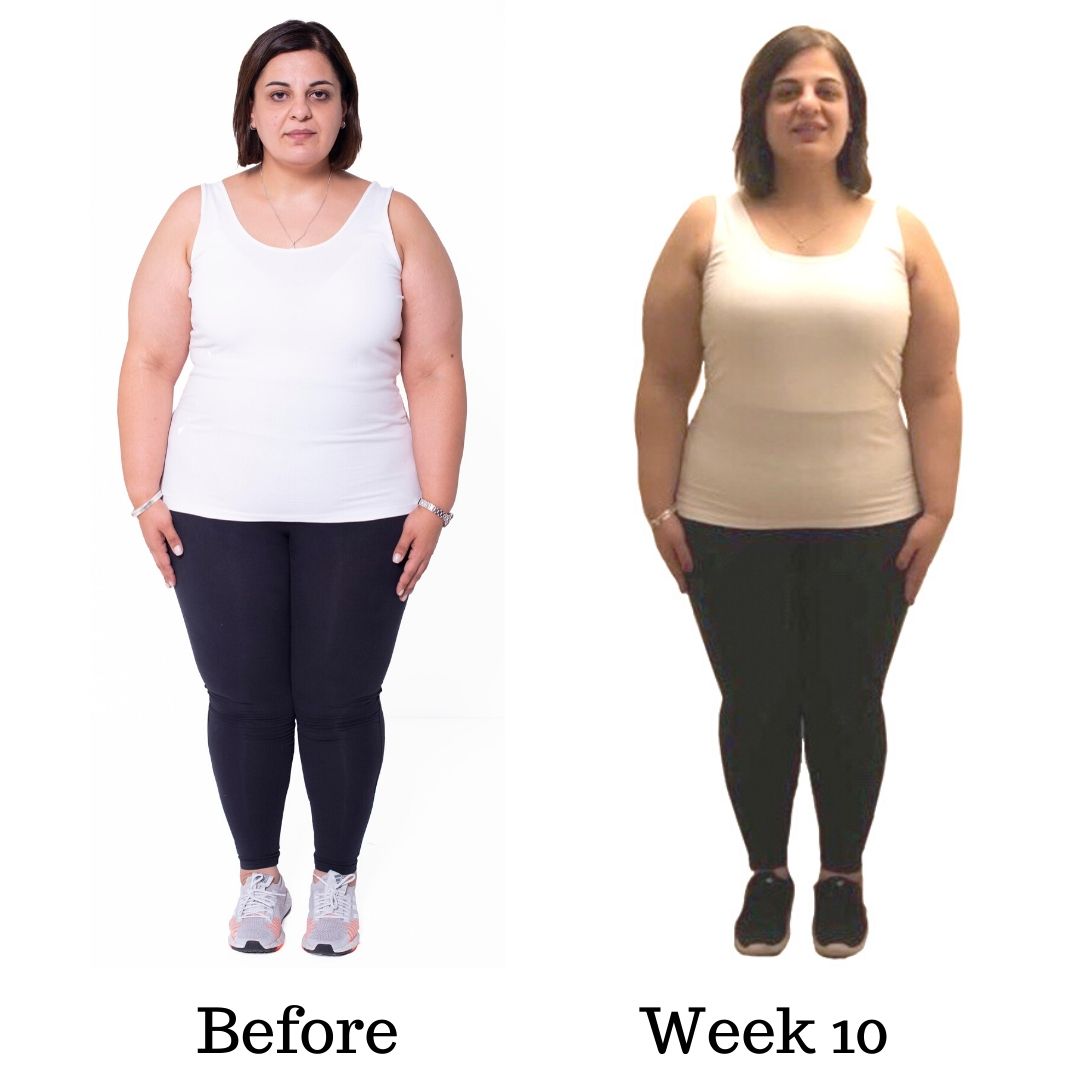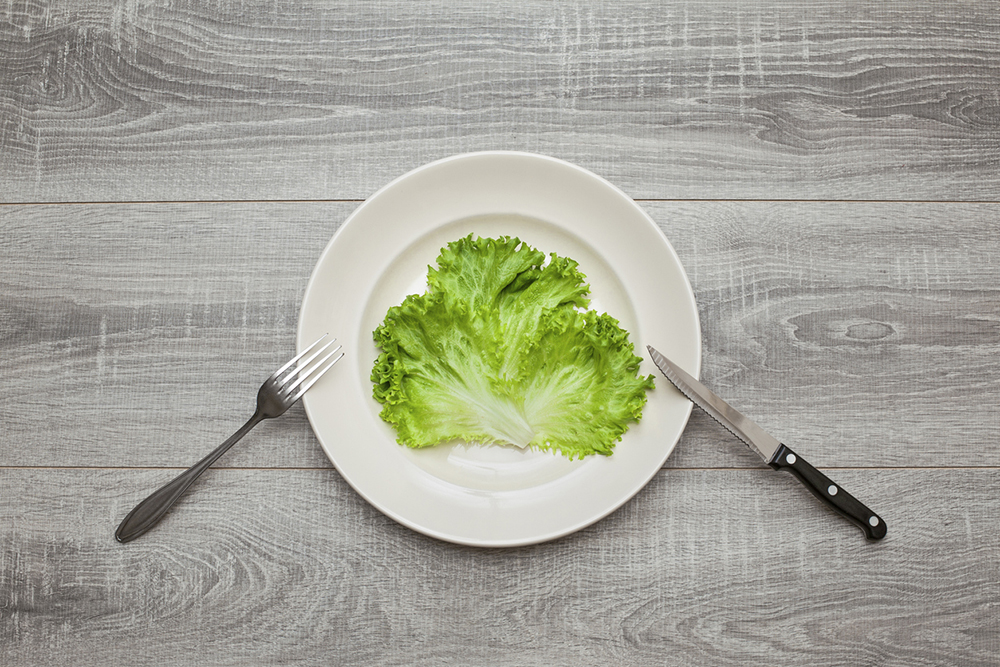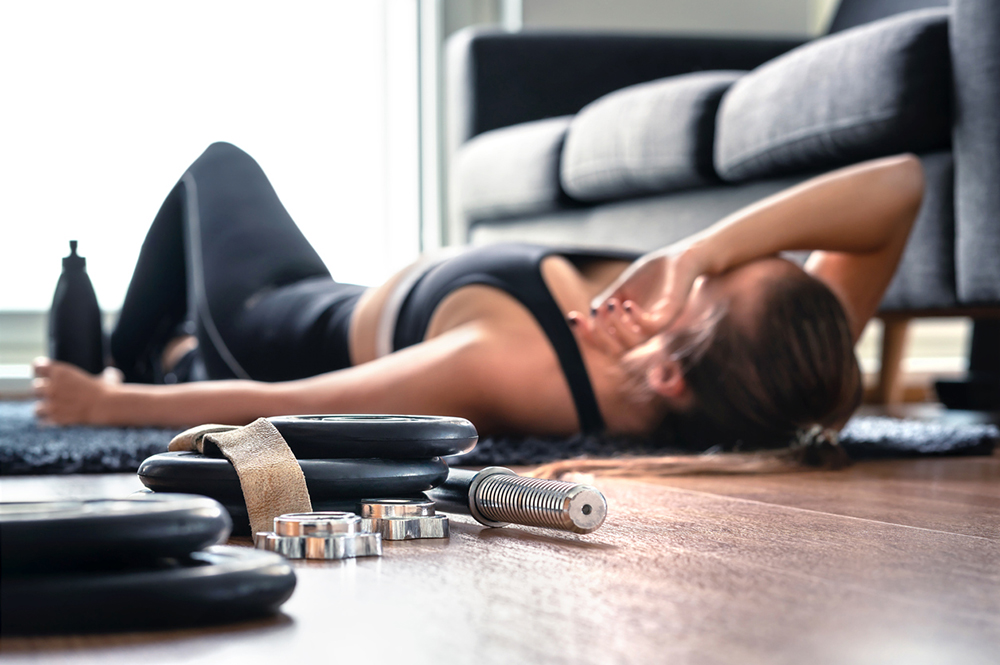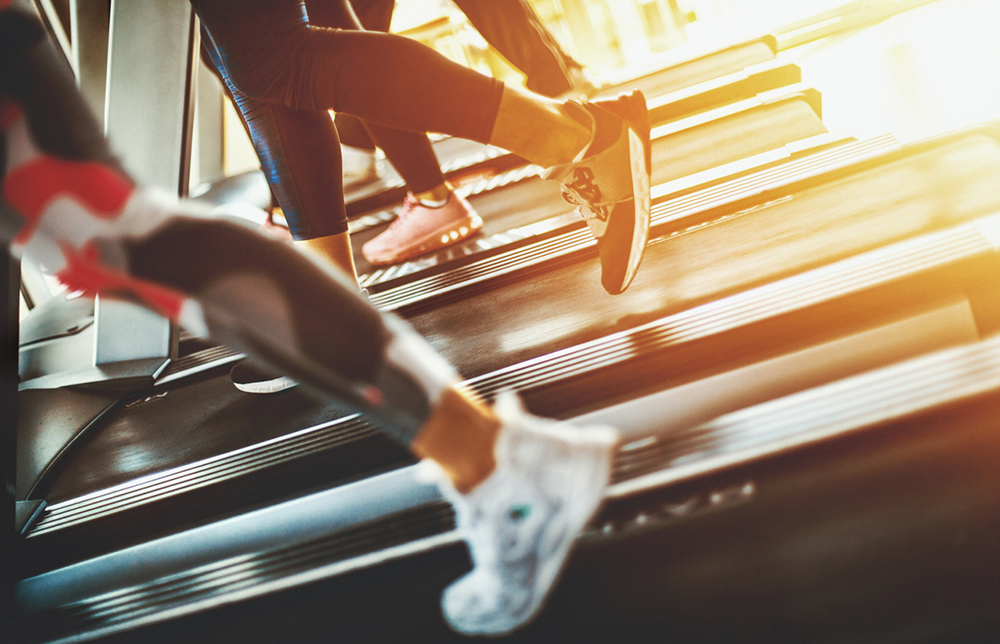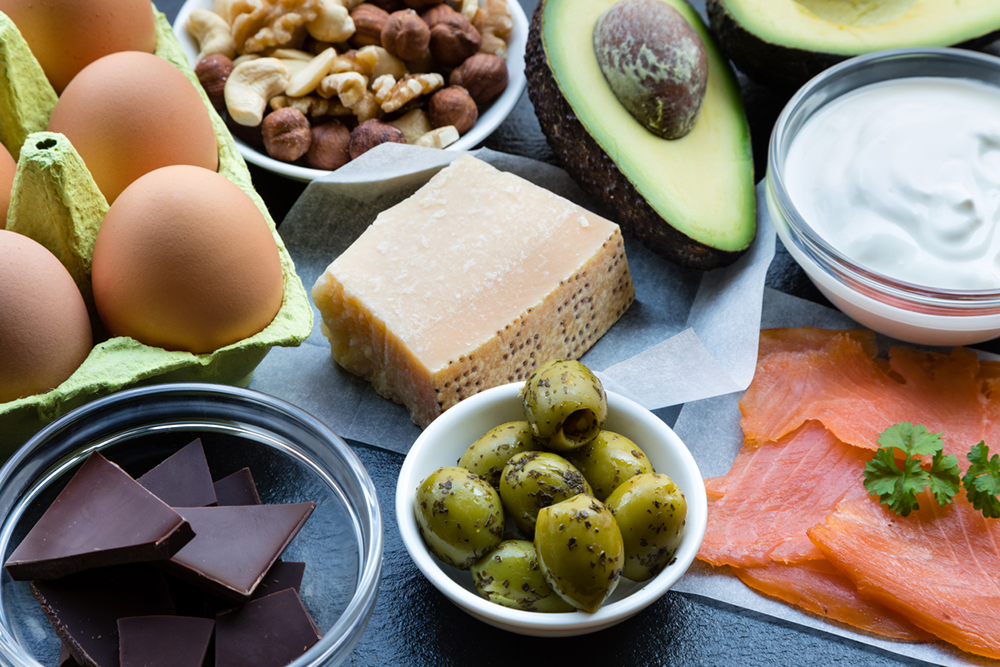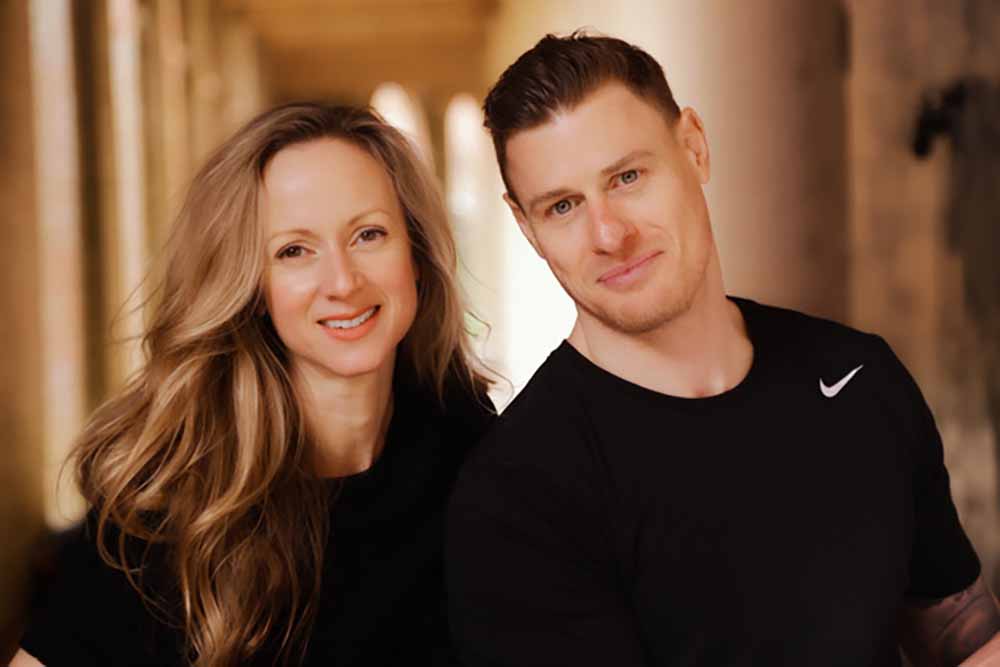Dina Hinar, 35 has lost almost two stone in ten weeks on her body transformation – this week she reveals the fat loss myths she discovered along the way
Welcome back to the next installment of my 10 week body transformation with Terry Fairclough, Luisa Valenti and their life changing Your Body Programme that has helped me lose nearly two stone in ten weeks.
I now have only two weeks left until my final weigh in and I really don’t want this journey to end.
I have now lost a total of 11.9 kilos (26 pounds) – that’s nearly two stone, I am speechless.
Not only have I lost the pounds but my measurements show that I have lost a total of 17 inches so far, seven of those coming off my waist.
| Before | End of Week 1 | End of Week 2 | End of Week 3 | End of Week 4 | End of Week 5 | End of Week 6 | End of Week 7 | End of Week 8 | End of Week 9 | |
| Weight (kg) | 120 | 116 | 115.5 | 114.8 | 114.2 | 113.2 | 112.5 | 110.7 | 109.2 | 108.1 |
| Chest (centimetres) | 118 | 116 | 115.5 | 112 | 110 | 109 | 109 | 109 | 107 | 107 |
| Waist (centimetres) | 115 | 114 | 113 | 112 | 108 | 100 | 100 | 99 | 98 | 96.5 |
| Hips (centimetres) | 141 | 139 | 137 | 135 | 132 | 131 | 131 | 130 | 128 | 127 |
| Total weight-loss | N/A | 4 | 4.5 | 5.2 | 5.8 | 6.7 | 7.5 | 9.3 | 10.8 | 11.9 |
I am over the moon and thrilled with my results but I have to admit, I have been having a few thoughts of ‘I wish I was losing weight quicker’, ‘why is my tummy taking forever to lose fat’, ‘how long will it be until I am happy with my body’ blah blah blah.
Terry and Luisa have had to remind me that this transformation is a long-term journey and if I want lasting results I need to lose weight slowly and sensibly.
There are plenty of myths out there surrounding weight loss that claim to help with those niggling thoughts you get when trying to lose weight, but no matter what these myths say or claim, you won’t lose weight in the long run if you make drastic changes to your diet and lifestyle.
I have fallen for these myths plenty of times and have almost always ended up gaining more weight than I lost, so this week I want to call them out in the hope that you don’t fall for them either…
#1 ‘Certain exercises will help you lose fat in specific areas’
Truth: You can’t spot reduce fat
Let’s be honest here – we are all guilty of attempting to slim down those tummies by doing hours of core work every week.
‘Far too often I have ladies in particular asking me, ‘what exercises can I do to get rid of the fat on my thighs, arms or stomach? or ‘How do I lose weight here and here?’, says Terry.
‘The truth is, you probably have already lost some weight in those areas, but you can’t spot reduce fat, that means you can’t loose fat from just one or two areas of the body.
‘You also can’t do one particular exercise to try and target one particular area. If you are in the process of losing fat your body will take fat from wherever it wants to take it from, and this is based on your hormones and genetics, not on what you ate that day or how many sit ups you did – it’s very individual from person to person’.
Unfortunately, your body isn’t really concerned about whether you have a six pack or about losing those love handles before your summer holidays. Physiologically, fat loss is a whole body mechanism and we can’t choose where our body loses the fat from.
An analogy Terry likes to use when I ask him why my tummy and legs are taking longer to lose the fat is this, ‘imagine you are on a plane flying from London to Russia, on that route you will have to fly over Germany. Right now you are over Germany which means you are on the right track and direction, but you have to be patient, we may be on our way to Russia but we aren’t there just yet’.
You just have to be patient and let the process happen – but can the fat around my tummy please stop being so stubborn and give a girl a break here. Thanks.
#2 ‘Significantly reducing your calories is the answer to fat loss’
Truth: You don’t have to starve yourself to lose fat
We’re all guilty of starving ourselves when we have gone to put on a pair of jeans and they ‘all of a sudden’ won’t do up. We skip breakfast, we live on soup, steer clear of the biscuit tin and book into 20 fitness classes.
This has wrong written all over it. In order to work out effectively at the gym in order to burn fat you need energy and you can only get that by eating a diet of healthy wholesome food. Of course, you do need to look at lowering your calories to create a calorie deficit, but not by so much that you are constantly hungry.
Starving yourself may work initially, but it certainly won’t work in the long run and you’ll be pretty grumpy 24/7, hungrier and crave naughty treats.
If you really are feeling hungry try having a protein shake. If my tummy started to rumble or I hadn’t quite reached my protein target for that day I would grab my shaker and mix some Healthista Lean Whey Diet Protein, £24.99 with some water – bye bye hunger pangs.
At the very start of my 10-week transformation, Terry asked me to track how many calories I would normally eat in a day which worked out to be around 2,500 calories.
Terry suggested that I lower my daily calorie intake to 2,000 for the first four weeks of the transformation. This was determined after looking at my height, weight, age and activity level.
This slight reduction was so that he could lessen my daily calorie intake to create a calorie deficit, but not by so much that my body would go into shock and starvation mode.
This ‘starvation mode’ lowers your metabolism, increases hunger signals, and increases the breakdown of protein for energy, instead of the breakdown of fat and carbohydrates for energy, which is the ideal source for energy.
This response causes your body to regain the fat that it has lost but also to store more fat for the next time you decide to starve yourself. Terry explained that the body is always going to find a way to prevent itself from losing weight. So, starving yourself will actually cause you to gain weight rather than lose it.
After four weeks into the transformation it was time for a further reduction in calories. Terry asked me to drop my daily calorie intake from 2,000 to 1,750 calories. And now after reaching week eight, Terry further dropped my calories from 1,750 to 1,500.
This may be a dramatic reduction in total but it has been over an extended period of time, giving my body time to get used to the gradual lessening of calories. Remember progressive weight loss is far more beneficial and longer-lasting than sudden dramatic weight loss.
From a scientific point of view, starving yourself also isn’t advised. Indeed studies on very low-calorie diets that provide less than 1,000 calories per day have shown that they can lead to muscle loss and significantly slow down metabolism.
You aren’t going to lose a stone in a week, and rapid weight loss isn’t just unhealthy but also isn’t maintainable. A safe, realistic and maintainable fat loss amount is around one to two pounds per week.
So, don’t starve yourself, you will only do more harm than good.
#3 ‘Spending hours in the gym will fast track your fat loss’
Truth: Too much exercise could cause you to gain weight
How long do you spend in the gym? 30 minutes? An hour? An hour and a half? You may want to start checking, as over-exercising can stop you from losing weight – yes you read that correctly.
Excessive exercise isn’t just unsustainable in the long run, but it may also lead to extra stress, which means elevated cortisol levels and therefore possible weight gain.
‘Cortisol is the body’s main stress hormone and cortisol levels caused by stress (including exercise) can cause the ‘shutting down’ of certain functions of the body including digestive, reproductive systems and even growth,’ explains Terry.
Raised cortisol levels caused by stress have been linked to weight gain, especially around the middle.
A study carried out by researchers at University College London (UCL) published in the journal Psychosomatic Medicine found that people who had higher levels of cortisol in their bodies tended to have larger waist measurements and a higher body mass index (BMI) than those with lower levels.
Studies have shown that the more intense the exercise, the larger the cortisol response. This makes sense – the bigger the stress to the body the bigger the response.
For example, high intensity type bouts of exercise such as HIIT training, lasting only 40 minutes can almost double resting cortisol levels, which is fine for a short while but not over extended periods.
So ideally you don’t want to be doing anymore than 40 minutes of high intensity exercise a day. Trying to force your body into burning more calories by spending hours in the gym and over-exercising, is not healthy and will not be effective in helping you to lose weight.
Spend no more than about an hour in the gym, 15 minutes of that should be spent warming up and ten minutes should be spent stretching, that leaves you with 35 minutes to get sweaty and raise your heart rate.
#4 ‘Running is the best way to burn fat’
Truth: Running isn’t beneficial for everyone
Every gym has one (or two or three) – the woman running on the treadmill every single day and never losing any weight.
Cardio such as running, is one way people can lose fat, but in comparison with weight training it is not the most effective or efficient way to reduce your body fat percentage.
When people run for long periods of time in an effort to lose weight and burn the fat, their bodies will start to lose muscle which is catastophic to fat loss as you need lean muscle to keep your metabolism fired up,’ explains Fairclough.
‘Running with your heart rate at maximum for a sustained period will cause the body to go into a ‘catabolic‘ state. This means your body will start to panic and think something is wrong and therefore will start using muscle to fuel your exercise rather than your fat stores,’ adds Fairclough.
Consequently, running (like over-exercising mentioned above) generates stress hormones in the body – including cortisol and adrenaline, which can cause the body to sore fat around the middle.
Oh and whilst running may burn loads of calories, it can also increase your appetite to such a degree that people eat too much to compensate.
If your body plateaus after endless hours of steady cardio training such as running, it’s time to lift some weights or even your own body weight in order to burn the fat.
Weight training builds muscle more effectively than cardio and promotes a boost in metabolism that carries on long after your workout is finished, known as the EPOC affect (excess post-exercise oxygen consumption).
The EPOC effect is also known as the afterburn effect whereby you burn calories throughout the day or through the night after an intense workout.
When done properly, both cardio and weight training will undoubtedly burn fat, if the goal is to drop your body fat percentage, you’ll need to burn fat and gain muscle at the same time.
#5 ‘Avoid fat where you can and opt for low-fat food options’
Truth: Removing fats from your diet will not help you to lose body fat
Eating fat does not make you fat. And removing fat from your diet will not mean you will reach your desired body fat percentage any quicker.
Indeed, some of the healthiest diets around the world include plenty of fats, such as Greek, Italian, French, Icelandic and Korean diets.
The Icelandic diet for example, is rich in protein from meat and fish and includes very little fruit and vegetables. The Korean diet consists of carbs such as rice but it’s combination with pickled veggies has been said to help with fat absorption.
Oh and who can forget the French diet which is definitely heavy in fat (think cheese and not to mention the red wine), but again the French aren’t overweight and are known to be healthy, so eating fat clearly does not necessarily contribute to fat gain.
Plus, the Greek and Italian diets are not short in carbs but when it comes to dressings they are usually pure vinegar and olive oil – so therefore full of fats.
All of these healthy diets are great and very different from each other, but what is the same is that the diets are based on whole foods. That means, no processed food and sugar, no cereal, no sodas, no canned food and no fast food.
So just because I have said fat isn’t bad does not mean you can go and buy yourself a pizza…
More and more research is showing how eating the right fats from whole foods, can actually boost your health and help your gut microbes flourish.
A recent five year trial followed 7000 Spaniards divided between a low fat diet and a high fat Mediterranean diet with extra nuts and olive oil, full fat cheese and yoghurt.
The study showed that a third less heart disease, strokes, diabetes and breast cancer in the high fat group, plus they even lost some weight.
So always opt for the full-fat version of dairy products. It may be higher in calories than a ‘low-fat’ option but ‘low fat’ often in reality means high sugar accompanied by emulsifiers, chemicals and preservatives that can disrupt your microbes.
#6 ‘You can eat whatever want as long as you work it off in the gym’
Truth: You can’t out train a bad diet
If weight loss is your goal there is one thing that can’t be stressed enough, you CAN NOT out train a bad diet.
The key to sustainable healthy living is creating a balance between exercise and nutrition. Not over doing one and hoping that it compensates the other.
Plus, you may think you need to burn off 500 calories to reach your calorie deficit, but if you’re honest with yourself, you’ll see that sometimes we give ourselves a little too much credit when it comes to our food choices and how much we actually eat in total or burn off at the gym.
Instead of eating what you want and then aiming to ‘burn it off’ at the gym, instead look at every meal time as an opportunity to make the best choices for your body.
We all have those cravings and slip-ups so don’t beat yourself up if you do eat something higher in calories – refocus, let go of the guilt and make your next meal a healthier option.
Come back every week to read Dina’s week by week diary of her weight loss transformation with Terry and Luisa from Your Body Programme, with tips and advice from the experts.
Your Body Programme was founded by Terry Fairclough and Luisa Valenti.
The idea came about after Terry and Luisa saw other personal trainers regularly offering the same generic plan to every client, regardless of gender, goal or body type.
Terry and Luisa are passionate about the need to train everyone as an individual to achieve maximum results, and therefore don’t use a one-size-fits-all approach.
Relevant Healthista Content:
5 weight loss secrets PT’s only tell their clients – body transformation week 8
9 mind tricks for weight loss that work – Body transformation week 7
How to break a weight loss plateau – Body transformation week 6
What to eat to lose weight – transformation week 5
3 workouts for weight loss – Body Transformation week 4
How your body type affects your weight loss – body transformation week 3
5 diet rules to lose weight from exercise – body transformation week 2
5 steps to starting a weight loss transformation – your new body starts here
I did a body transformation and lost 11 inches – this is what REALLY works for fat loss
Healthista Content You May Also Like:
7 best Golden Globe body transformations
9 diet rules this celebrity personal trainer lives by
Body transformation week one – operation FAT LOSS
5 fat loss supplements proven by science
Like this article? Sign up to our newsletter to get more articles like this delivered straight to your inbox.



